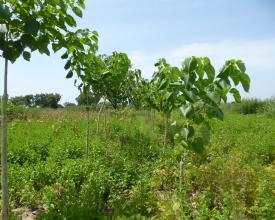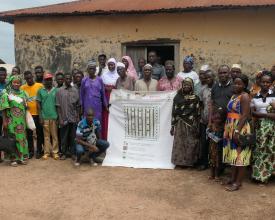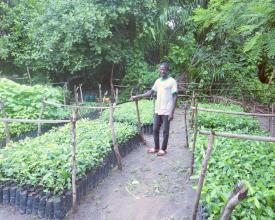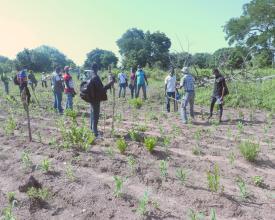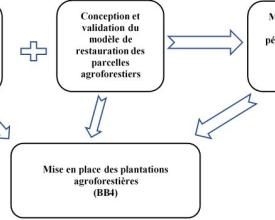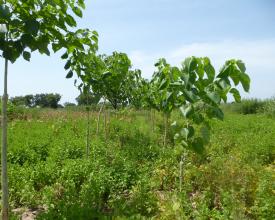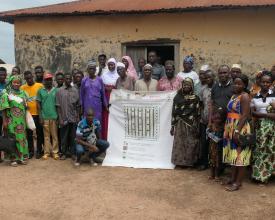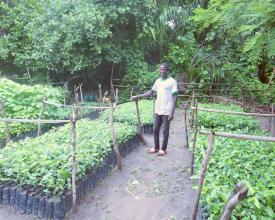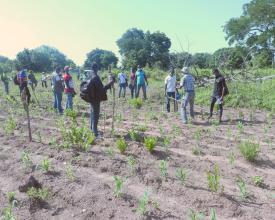Restoration of agricultural land in the Tchamba prefecture (Central Region of Togo)
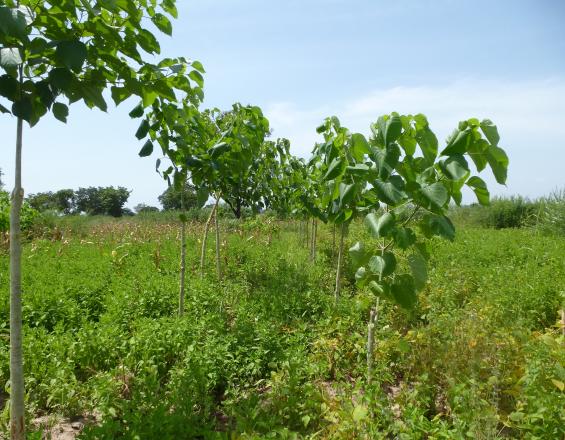
Agroforestry landscapes play an important role in food production. Yields depend on soil fertility and quality. In Togo, over 80% of the population is active in agriculture, which contributes 40% of GDP. Rapid population growth and farming practices have contributed to land degradation and impoverishment. In Tchamba, 498 ha of agricultural plots have been delimited, mapped, put under restoration and documented with the approval of beneficiary households as part of the Forests4Future (F4F) project in 2021. The restoration model proposed consisted in improving existing practices in the area. It aims to increase the density of Néré and Karité in the fields (NTFP exploitation), combine crops with Cajanus cajan (soil enrichment) and edge plantations with fast-growing species (energy wood production).
Context
Challenges addressed
Environment:
- Soil impoverishment due to slash-and-burn agriculture, pesticides, herbicides and chemical fertilizers.
- Water cycle and carbon stock disrupted
- Land requirements for agriculture cause deforestation. Areas are totally deforested. Shorter fallow periods
- Invasion of the Abdoulaye wildlife reserve and community forests due to increased dependence on wood for energy.
Socio-economic:
- Soil degradation and loss of fertility, declining crop yields and loss of valuable tree species in the landscape are directly hampering sustainable economic development and affecting people's livelihoods.
- Women's groups involved in the collection and processing of Néré and Karité and other NTFPs are faced with a shortage of raw materials and are forced to travel long distances.
- Rampant demographic growth (2.84% per year) is increasing pressure on natural resources.
Location
Process
Summary of the process
428 identified beneficiary households made 498 ha of their farmland available for restoration. The total area and its geographical distribution were the result of mapping and geolocation activities. Building Block 1 (BB1) forms the basis for Building Block 3 (BB3) and Building Block 2 (BB2), the starting point for restoration actions. A concept note for the model was proposed by the project and validated by project stakeholders (BB2), identifying the species and number of plants to be produced per BB3 nursery site. The 18 nursery groups were identified, trained and equipped to set up and produce quality seedlings (BB3). The seedlings were transported to the restoration sites (Building Block 4, BB4). BB4 based on BB1; BB2 and BB3. The "Encadreurs/Ambassadors", 23 young people from the project's 5 cantons, were trained and equipped to accompany the beneficiaries in setting up the plantations.
Building Blocks
Restoration of agricultural plots for beneficiary households
Using a participatory, inclusive and non-discriminatory approach, beneficiary households are identified through awareness-raising workshops in all project villages. The principle is voluntary and unconstrained, and includes the restoration of at least 0.5 ha of cultivated land capital for each farming household. Each plot is inventoried, geolocated and mapped. The condition of each plot (cultivation history, yield, trees present, etc.) is established and well documented. The restoration of the plot is carried out bilaterally, with each party contributing its share: the project 80% (payment of ambassadors, provision of seedlings, contribution to site preparation, etc.) and the household 20% (in kind, search for stakes, planting, maintenance of the plantation).
Enabling factors
- Strong collaboration between former GIZ projects (ProREDD, ProENERGIE, IWP),
- Availability and good integration of the implementation team (DFS team),
- Commitment and active participation of all local administrative authorities (prefectoral, communal and cantonal) in the activities;
Lesson learned
- The participatory and inclusive approach, with support for community leaders at grassroots level. This involves support, especially for landowners, from the prefect, mayors of the three communes, canton chiefs and village chiefs. In fact, the land does not belong to the farmers or farming households. The owners' agreement was required to place these areas under restoration.
- Simple household selection criteria, voluntary and inclusive participation
- A combination of appropriate local governance and the communication process proved successful.
- Compromise reached between landowners and farmers for the distribution of the usufruct linked to the harvesting of energy wood, without however hindering previous negotiations between these two categories of stakeholder.
- Involvement of transhumant herders and peuhles in activities (awareness-raising) to reduce the negative impact on plantations.
Farmland restoration model
The agroforestry ecosystem restoration model proposed by the F4F-GIZ-DFS project is the fruit of a concept note validated by the relevant technical departments of the Ministries of Agriculture and the Environment, and by local authorities and grassroots communities. It involves the establishment of agro-forestry plantations on the plots of land of households that have voluntarily agreed, with the consent of the landowners, to put at least 0.5 ha of their farmland under restoration, while continuing agricultural production on the restored plot. The aim of these plantations is to increase crop yields, the carbon sequestration capacity of agroforestry parks and the income of beneficiary households, for greater socio-economic and environmental well-being in the Tchamba prefecture.
Enabling factors
- Design and validation of the concept note by the technical departments of the ministries concerned, local authorities, NGOs and grassroots communities.
- The restoration model is a combination of existing endogenous practices in the area.
- Good collaboration between the project team, local authorities and grassroots communities.
Lesson learned
- It was crucial to maintain the interest and support of local communities in the process. This required ongoing communication and awareness-raising.
- Guaranteeing land tenure security for landowners was of paramount importance for the adoption of the model.
Resources
Promotion of local village nurseries for the production of forest and agroforestry seedlings
To achieve the objective of mobilizing all social strata, in particular young people and women, the F4F project has opted for the production of seedlings (required for restoration) by local village nurseries. This option has the advantage of avoiding the long distances involved in transporting seedlings, and above all of helping to increase the incomes of young people and women. In addition to the 8 nursery groups, F4F proposed to encourage and support other nursery groups, bringing the total to 18 groups spread across the 5 project cantons. The 18 groups were trained (2 members per group) and provided with production inputs (seeds and nursery equipment). Each group received close advisory support and financial backing for the production of higher-quality seedlings. The seedlings produced were transported by the same actors to the restoration sites during planting activities.
Enabling factors
- Availability and willingness of young people and women to participate in project activities,
- Collaboration with existing nursery groups set up by previous projects,
- Initial technical capacity building (training) of groups (2 members per group, old and new),
- Good mastery of local species silviculture by nursery groups;
Technical, material and financial support from the project to each nursery group.
Lesson learned
- Rapid appropriation of production techniques by members of the new groups.
- Good organization and perfect control of time and schedule (site preparation, seed acquisition, setting up nurseries in germinators or direct sowing), which forms the basis for the production of vigorous, well-weeded seedlings;
- Protection of the production site from roaming animals and unauthorized access;
- timely availability of plants for restoration activities.
Restoration model for agroforestry plots and mobilization of local skills
With a view to perfectly replicating the restoration model in the field, with the aim of having a single basis for assessing the plantations of beneficiary households and the contribution of local expertise, the F4F project has set up a group of actors known as "Encadreur ou Ambassadeur". These are 23 young people from the project's 5 cantons who have been trained and equipped in the restoration model. Their task is to support each beneficiary household in carrying out planting activities. The households' contribution (20%) consisted of site preparation work, finding stakes and staking, planting and maintaining the seedlings. The project plans to award prizes to encourage the best households.
Enabling factors
- Local skills available within the grassroots community
- Good understanding of the restoration model by beneficiary households
- Agreement of landowners
Lesson learned
- An agreement between the farmer and the landowner is essential before any action is taken in the field, otherwise there is a risk of sabotage and vandalism of the plantations.
- Guaranteeing security of tenure for landowners
- A definition of the key to the distribution of usufruits linked to the exploitation of border plantations.
- Involvement of transhumant Peulhs in restoration activities (awareness-raising and compromise on grazing management), as Cajanus cajan is highly appreciated by cattle.
Impacts
- 428 households involved in the restoration of agricultural plots
- 32 members of 18 nursery groups were trained, provided with equipment and obtained additional income from the production of seedlings.
- 23 young mentors (model ambassadors) were trained and involved in supporting beneficiary households in implementing the restoration model
- 297,000 seedlings (all species) were produced for the restoration of agricultural plots.
- Improvement and restoration of soil fertility and increased crop yields
- Increased number of Néré and Karité trees in the landscape for climate regulation and carbon storage
- Supply, in the short term, of wood energy (self-consumable and saleable) to households and generate additional income
- Improved microclimate for crops
Beneficiaries
- 3 communes,
- 5 cantons
- 25 villages
- 428 households, including women and young people
- 18 nursery groups
- 16 value chain groups (Shea-Néré, Honey, Wood energy)
Sustainable Development Goals
Story
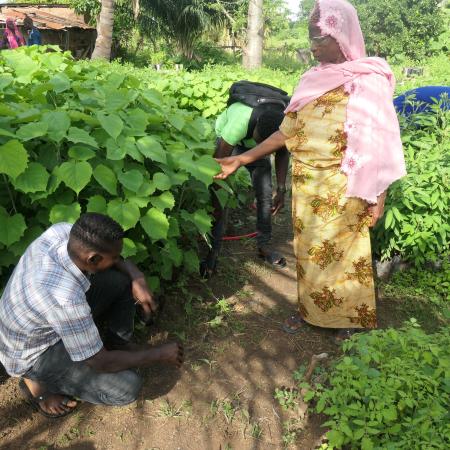
By Mrs OKE Adiétou, Nursery gardener in the canton of Koussountou
I followed the first campaign to identify F4F project beneficiaries and decided to become one of the local players to support the project. We set up a nursery group called "Broukou-Nafa" after receiving training in the subject. After the death of our group president in March 2021, I took over as group president. As a result, for the 2021 agroforestry restoration campaign, we were able to produce 8,000 forest seedlings worth 320,000 CFA francs (€487.84). This has helped us to provide for my family.
